Menu
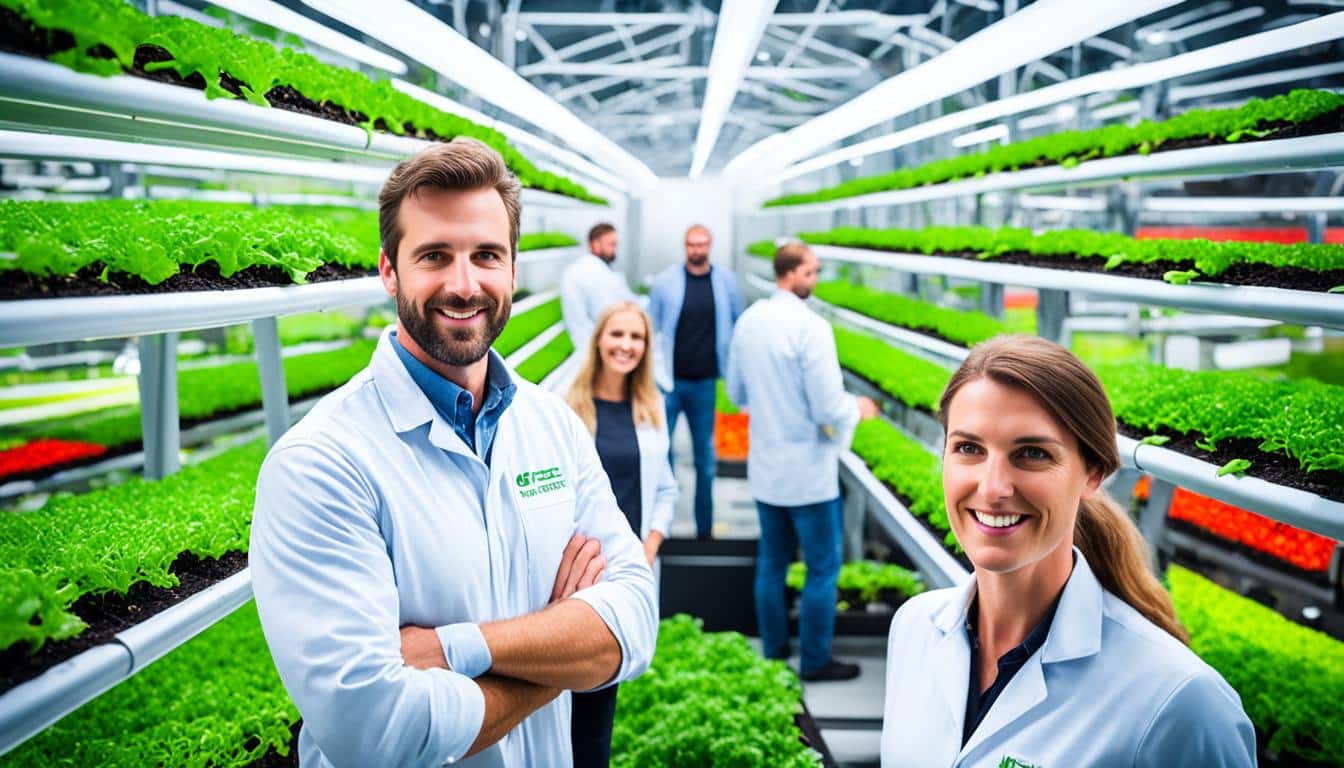
By 2050, the world needs 68% more food because our population is growing. Already, our food system creates 26% of the world’s greenhouse gases. This is why we must change how we produce food to protect the future.
Fields like automation, precision farming, and vertical farming are making big changes. They’re making food production more efficient. Also, making meat from plants or in labs is becoming popular. This shift can use our resources better. Right now, a lot of land grows food for animals, not people.
Precision farming is smart because it tailors water and nutrients for plants. Vertical farming grows food upward, saving space and sometimes being hundreds of times more efficient. Singapore started selling lab-grown meat in 2020. This move is a big step towards worldwide sustainable food production.
Mixing new technology, rules, and working together is key for a better food future. This plan aims to not only meet food needs but also to protect our planet and make sure we can eat well for a long time.
The need for collaboration in agriculture is key as we try to feed a growing world. By 2050, we must boost food production by up to 68%. Yet, the current system causes about 26% of all global greenhouse gases. This makes future farming a big challenge.
New agricultural partnerships are vital for facing the big problems. This involves the help of many, such as governments, businesses, and thinkers. Look at how Singapore okayed cultured meat in 2020. It shows how government backing leads to remarkable food solutions.
Working together in farming brings major challenges but also big chances. A significant bit of farmable land needs repair. Working together more can fix this by combining resources and knowledge.
But, there’s good news. Better farming connections could boost the world’s economy by $500 billion by 2030. This would make farming more productive and smarter. Plus, it’s predicted that plant-based meats will be a big part of the future market. So, these teamwork efforts could push major changes in how we make food, making it more sustainable.
Technology is changing how we farm and it’s a big deal. With the world’s population set to hit 9.7 billion by 2050, the future of agriculture relies on tech. Things like automation, robotics, and precision farming help with both producing more food and caring for the planet.
Today, machines are doing more of the farm work. We have self-driving tractors and drones keeping crops healthy with instant info. Using robots cuts down on work and makes farming more exact. For example, in Newark, New Jersey, a vertical farm is almost 400 times as effective per square foot as the old ways.
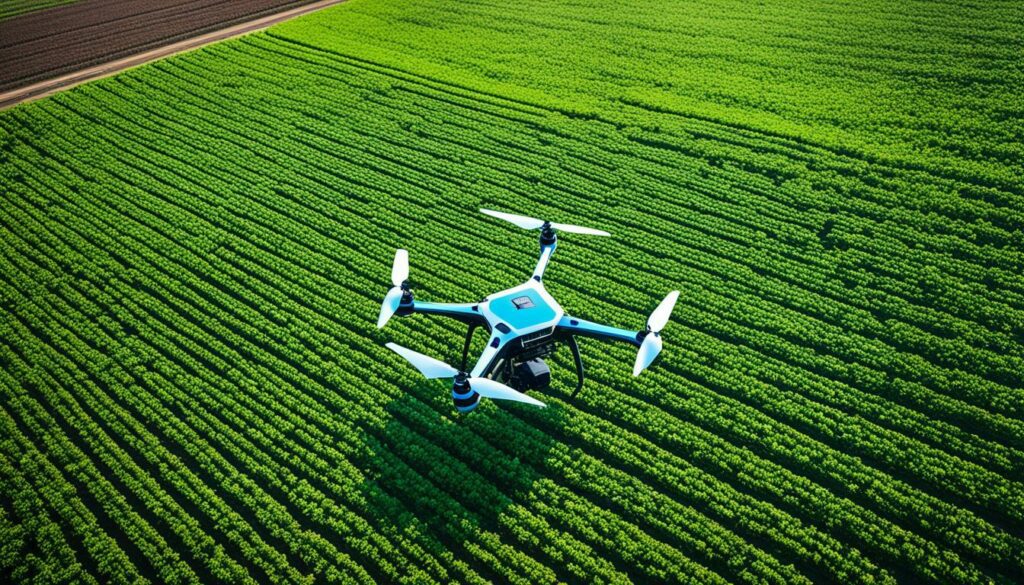
Precision farming uses technology to feed, water, and protect crops just right. This helps us get more food from the same land with less harm to the environment. An approach like this could slash 9.8 gigatons of CO2e by 2050, a recent study says. Companies like Phytech and Syngenta are showing us how to use tech to watch our plants and dirt better, making farming smarter.
| Technology | Benefits | Statistics |
|---|---|---|
| Automation | Reduced labour costs | Labour cost savings of up to 40% |
| Robotics | Enhanced accuracy | Precision in planting and harvesting |
| Precision Farming | Efficient resource use | Up to 50% water savings |
| Digital Monitoring Tools | Improved crop health data | 300 million IoT endpoints by 2024 |
The future of farming will be very tech-friendly. Improved links and using precise tools may boost the world economy by more than $500 billion by 2030.
The focus on sustainable farming is key for the earth’s health. It helps us manage our resources in farming better. Basic ideas like looking after the soil, saving water, and promoting many types of life are the heart of this. For the soil to be healthy, farmers use cover crops, switch up what they grow, and add organic stuff. This stops the soil from being carried away by wind or water. It also helps the plants grow strong and be able to deal with tough times.
Biodiversity is critical for keeping the environment steady and rich. Growing different plants together and mixing up what’s planted where, helps all sorts of useful creatures thrive. This way of farming helps keep away harmful bugs and makes the plants stronger against diseases.
Looking after our water is essential in farming that keeps going without using too much. Ways like dripping water straight to the plant roots and being very exact about where and how much water crops get, are important. Drip irrigation, for example, uses less water because it goes straight to where it’s needed. This stops the water from just evaporating or running off into the ground.
| Practice | Approach | Benefits |
|---|---|---|
| Cover Cropping | Use of specific crops to cover the soil | Reduces erosion, enhances soil health |
| Companion Planting | Planting complementary crops together | Boosts biodiversity, natural pest control |
| Drip Irrigation | Direct water application to plant roots | Conserves water, increases efficiency |
| Precision Agriculture | Utilising technology for accurate farming | Improves yield, minimises waste |
| Rainwater Harvesting | Collecting and storing rainwater | Provides supplementary water source |
Efforts such as MasAgro in Mexico have shown that sustainable farming can improve how much food we get and how farmers live. The System of Rice Intensification (SRI) helps grow more rice using less water and chemicals. New technologies like farming upwards in cities and really precise ways of growing are set to make things even better without hurting the planet as much.
In the bigger picture, we aim for top productivity with very little waste. Measuring this is what Total Factor Productivity (TFP) does. TFP means getting more with just a little use of things like land, water, work, and money. This idea has helped lower poverty and make sure there’s enough food around the globe for the last 50 years. It shows that sticking to sustainable farming for the long haul is a wise choice.
In today’s world, cities are growing quickly. This means we need new ways to produce food close to people. Urban and vertical farming offer a way to tackle food security and environmental issues. By growing food near urban areas, we cut down on the distance it travels. This leads to less pollution and helps urban areas grow food in more sustainable ways.
Food that travels a long way to reach you adds a lot to the planet’s carbon footprint. Urban vertical farms are changing this by growing food right in the heart of cities. AeroFarms and Plenty are examples. AeroFarms uses aeroponics and LED lights to save 95% of water. Plenty focuses on producing high-quality food using fewer resources.
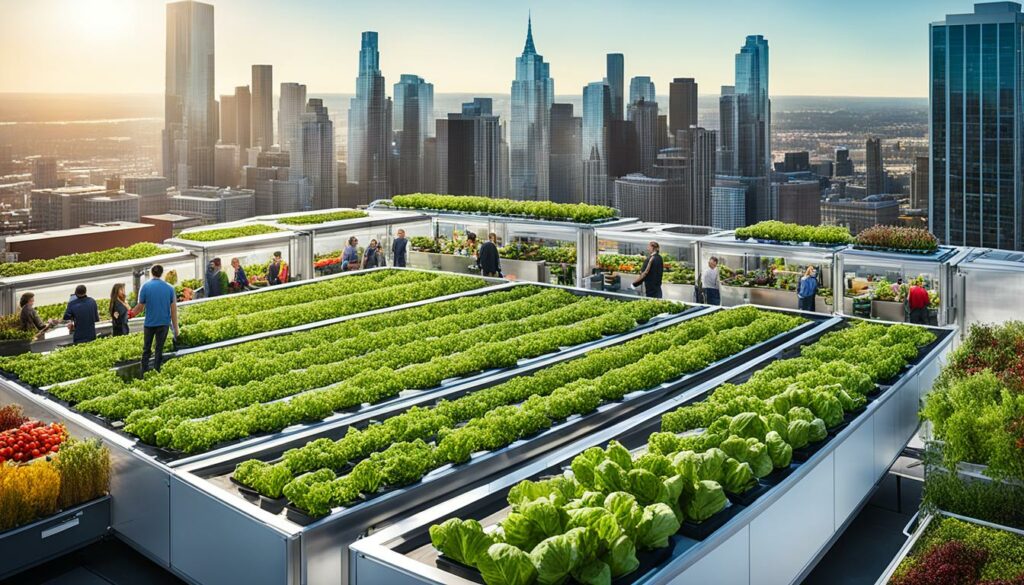
These farms also meet the growing need for locally sourced food in cities. They are becoming popular among investors and big companies. The global market for vertical farming could grow to USD 30.58 billion by 2030. This is thanks to a 24.6% annual growth rate.
Hydroponics and aquaponics are key technologies in urban farming. Hydroponics grows plants in nutrient-rich water without soil. Aquaponics combines this with fish farming. It creates a system where plants and fish support each other. These methods use less water and reduce the need for harmful chemicals.
The vertical farming industry is forming new partnerships. This includes deals with food sellers and tech providers. INFARM and Future Crops are leading the way. They show how hydroponics can be used in cities to farm food. This points to a future where urban farming is both big and green.
There are some energy concerns because these farms need a lot of lighting and climate control. But, advances in AI and automation are helping. These technologies make farming more efficient and less dependent on manual work. This paves the way for a sustainable food future.
In the end, adopting these new farming methods is a big step for agriculture. It aims for a future that’s more efficient, greener, and closer to the people it serves.
The world of farming is always changing. Working together will help with big challenges. Key trends include sharing research, focusing on sustainability, and making the most of resources. These will make farming partnerships strong and effective. They will also lead to new ways of working that help the environment.
Collaborative research and development are vital in farming. It brings together different groups to make big steps forward. This teamwork helps create strong crops, use digital tools better, and make producing food more efficient. For example, the Crops of the Future Collaborative involves top names like BASF, Bayer, and Syngenta. They study how traits, genes, and the environment all work together. This helps tackle issues like pests, diseases, and extreme weather. It makes our food supply more secure and robust.
Looking after the earth and its resources is at the heart of farming’s future. The USDA says digital farming is key to dealing with rising costs and climate changes. Practices that protect the land, like not tilling the soil and using less chemicals, are important. They help soil, plants, and the whole ecosystem thrive. There is also a growing interest in how our food is produced. People want to know it’s done in a way that’s good for the planet and fair to everyone. Tools like food-sharing apps and smart storage help cut down on waste. Farming this way supports a healthy environment and a strong future. It makes sure we make the best use of resources and look after the planet.
| Agtech Training Courses | Agtech Toolbox Website | Agtech Demonstration Hubs | Development Officers | Agtech Alley Events |
|---|---|---|---|---|
| Available as part of the Agtech Education Program | Information on Ag IoT devices, suppliers, case studies, and events | Located at multiple NSW DPI research stations and farms/universities | Collaborate with farmers to explore Agtech solutions and provide training | Opportunities for suppliers to showcase products and network with potential customers |
Coming together in farming partnerships will change the game. By using new technologies and being sustainable, these partnerships will help with major global problems. They will improve food security, help manage resources better, and protect the environment.
The role of government support in agriculture innovation is essential. Worldwide, governments give around USD 540 billion a year to agricultural producers. This is about 15 percent of the total value of what they produce. It shows their big effort to ensure there is enough food and bring new ideas into farming.
But, the amount of help might grow to nearly USD 1.8 trillion by 2030 if things don’t change. This huge jump means we need to be smarter in how we use this money. We must stop giving help that doesn’t really help and find better ways to support farmers that are also good for the planet and the people.

Some countries are already working towards better and more effective ways to help farmers. However, the need for a bigger, braver action by all countries is clear. There are six key things to do: check how much help is given now, see what good or bad it does, plan how to use this money better, predict the effects in the future, improve the plan, and check if the chosen actions are really working. This careful way of working makes sure the money helps where it’s needed and it’s good for the Earth too.
Important health groups like the FAO and WHO are giving guidance to governments. This guidance (the Sustainable Healthy Diets Guiding Principles) helps officials make policies good for health and also the planet. Reports by UNICEF and the Lancet are also pointing out we need strong, helpful policies to fight global health issues.
Our industrial food system is very significant, adding almost $1 trillion to the economy, more than 13% of the Gross National Product (GNP). Nearly one in every six workers finds a job in the food sector. This data makes it clear how crucial government support in agriculture innovation is for our jobs and economy.
When we shop for food, almost a fifth of our spending goes to food stores and restaurants. Knowing this, governments should create ways for farmers to come up with new ideas. They should also help keep food production close to where people live. This stops us from missing out on fresh food because of fast-growing cities.
There is also a challenge with who’s working in farming. Many farmers are getting older, and this is the same for those who own farms. Strong policies can make the farming sector attractive to younger people. This way, we can have an agriculture that is strong and can support itself in the future.
| Key Focus Areas | Statistics |
|---|---|
| Annual Global Agricultural Support | USD 540 billion |
| Projected Support by 2030 | USD 1.8 trillion |
| Contribution to National Economy | $1 trillion |
| Employment in Food Sector | 17% of labour force |
| Community Retail Sales from Food Outlets | Up to 20% |
In our world today, tackling food scarcity needs countries to work together. It’s vital to boost food production sustainably by up to 68% by 2050. This rise is because more people will need food. So, building trade ties and working across borders is key.
In December 2022, a report from the Food and Agriculture Organization (FAO) sent a warning. It said if we don’t act, we will face ongoing food troubles and harm the planet’s resources. The report points to 18 main problems like poverty, inequality, and unstable politics.
The FAO mapped out four key ways to make a change:
Global trade deals are crucial for a wide variety of food sources. These agreements help to share farming know-how, tech, and good ways of working. They are critical for fighting food shortages. The World Economic Forum Meeting at Davos is a place where world leaders discuss food safety.
| Scenario | Description |
|---|---|
| More of the same | Current practices continue unchanged, risking increased food insecurity. |
| Adjusted future | Minor adjustments towards sustainability without major shifts. |
| Race to the bottom | Competitive decline leading to resource depletion and economic stress. |
| Trading off for sustainability | Significant shifts prioritising sustainable practices and equitable growth. |
Countries need to form strong bonds and do things that won’t hurt the planet. By improving trade, we make sure everyone has enough to eat. This is vital for our planet’s future.
Using new technology is key to changing farming and meeting global food needs. Working together is essential for new ideas in farming technology and AgTech.
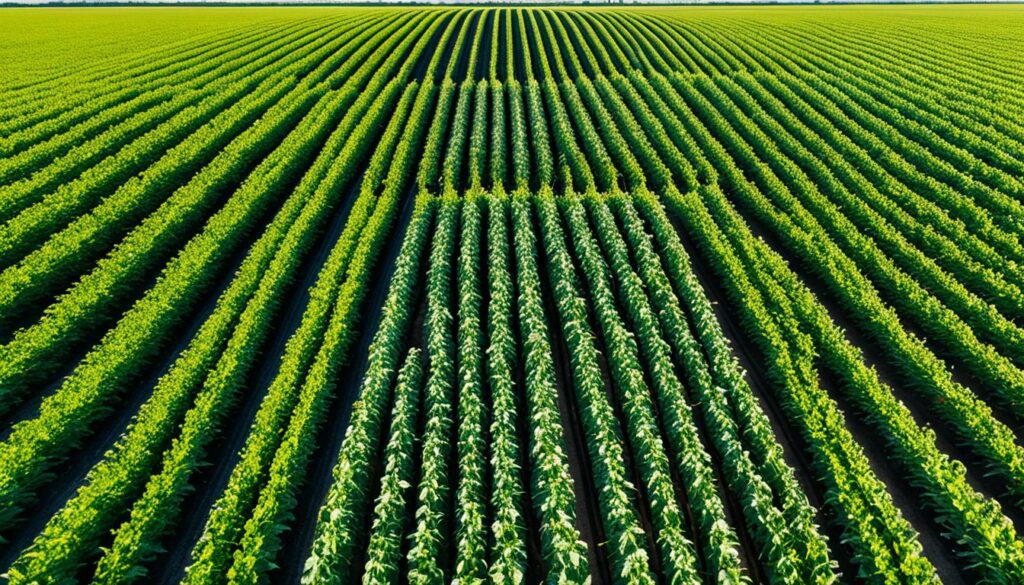
New tech is quickly making big changes in farming. Cultured meat – grown from animal cells – is changing the game. In 2020, Singapore was the first to sell it, showing it’s the future. Companies like Beyond Meat are leading with plant-based meats. They could be 10 percent of all meat by 2029. Precision farming is also huge. AeroFarm in New Jersey grows food in tall buildings. They’re 390 times more efficient than regular farms.
Mixing new tech with smart investments leads to farming’s future. The Crops of the Future group teams up for better crops. They put in $20 million to make crops that withstand climate change and are more nutritious. Beyond Meat grew fast, from $1.5 billion to $13 billion, because it invests in tech. Funding AgTech startups leads to new ways to make food. This includes making food with less impact on the planet.
The fight against climate change is closely tied to how we produce and eat food worldwide. Our current way of farming creates 31% of all greenhouse gases. It causes 88% of the world’s loss of natural spaces. To stop this, we need everyone to work together.
The Louis Dreyfus Company is a big player in this. They’ve promised to stop cutting down forests for farmland by 2025. Most products will follow this rule by 2020. This shows they are serious about saving our planet for the future.
The Company also wants to change the way we farm. They plan to improve 3 million acres of land by 2030. This will help 30,000 farmers. They are focusing on better ways to take care of the soil and grow crops to reduce pollution.
Partnering with The Nature Conservancy, the Louis Dreyfus Company is working on farms that grow grains, oilseeds, coffee, and cotton in the US, Canada, Brazil, and Argentina. Together, they aim to find new ways to fight climate change on these farms. They are testing these ways on crops like oranges in Brazil and coffee in Vietnam, Indonesia, and Uganda first.
It’s urgent because by 2050, we’ll need to feed 10 billion people. Right now, making food creates a lot of pollution and damages a big part of our lands. This is why it’s so important for groups to work together, finding new ways to farm that are good for the earth.
| Factors | Impact on Climate | Collaborative Initiatives |
|---|---|---|
| Greenhouse Gas Emissions | 31% from Agrifood Systems | LDC & TNC Collaborations |
| Deforestation | 88% from Agricultural Expansion | LDC’s No Deforestation Policy |
| Regenerative Farming | 3 million acres targeted by 2030 | Pilot Projects with Local Agronomists |
| Global Food Demand | 10 billion people by 2050 | Integrated Climate Mitigation Strategies |
The Regenerative Innovation Portfolio is off to a strong start with €30 million to begin and €5 million more each year until 2025. Over 25 companies, including Diageo, have joined. This shows these efforts are key in making farming more resilient to climate change and less damaging to our planet.
By following the EU’s Corporate Sustainabilty Reporting Directive, the Portfolio helps companies cut back on their pollution. These actions are at the heart of our fight against climate change in farming. They are guiding us to a future where farming is good for the earth.
Agriculture is changing fast. Corporate teamwork is at the heart of these changes. It brings new ideas and helps our planet. Global companies work together with governments to make these changes happen.
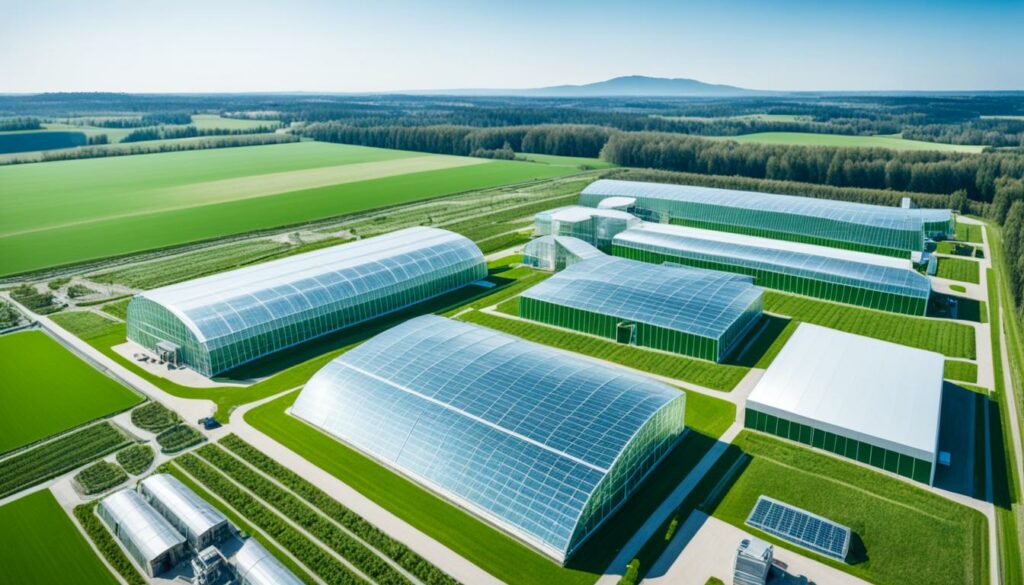
Big international companies are leading the way in making farming better. They put a lot of money into new farming techniques. For example, the Bezos Earth Fund gave $57 million to support better food practices. This big step shows they care a lot about the future of farming. The African Climate Foundation also set up a group to improve farming in Africa. This is a team effort to make farming more sustainable.
In 2023, a lot of money was promised to make farming greener. Foundations and private donors offered over $2.1 billion before COP28. IKEA and The Rockefeller Foundation together asked for over $200 billion to cut back on harmful farming practices. More than 134 countries agreed to make farming better for our planet. This shows that the whole world is coming together for our food and future.
When the public and private sectors work together, farming gets better. They work on finding new solutions and making farm systems stronger. For example, in India, digital farming could add up to $65 billion to the economy by 2025. Acumen’s Impact Fund is also putting $58 million to help farmers deal with climate change. This supports farming efforts to be tougher and better for the planet.
Big companies are also investing in foreign countries to fight climate change. At COP28, they promised $700 million to help cover losses from bad climate events. Together, they aim to double the amount of food we produce. This would help the planet and make life better for farmers. Even with some challenges, these efforts are making a real difference.
| Initiative | Investment | Focus |
|---|---|---|
| Future of Food – Bezos Earth Fund | $57 million | Sustainable Agriculture |
| Impact Fund – Acumen | $58 million | Climate Adaptation |
| Agricultural Digital Methods – India | $50-65 billion (projected by 2025) | Digital Farming |
New tech like blockchain, vertical farming, and gene editing is showing great promise. With the help of global agricultural groups and corporate teams, we are looking towards a greener and healthier future. This shows how looking ahead is changing the game in farming.
The growth of alternative proteins is changing our food world. New trends show people moving towards plant-based and lab-grown meats. This offers more sustainable choices for us all.
By 2050, we’ll need 68% more food to feed everyone. But, our current way of producing food creates 26% of the world’s greenhouse gases. This pushes us to invent new, better ways fast.
People are cutting down on meat and dairy to help the planet. By 2029, fake meats might grab 10% of the total market. Beyond Meat, for example, grew hugely, going from $1.5 billion to $13 billion in value in just three months.
Cultured meat is also gaining ground. In 2020, Singapore was the first to sell this type of meat. At the same time, NovaMeat in Barcelona made the first 3D-printed plant meat. This shows we’re moving towards some amazing new food technologies.
Sales of plant-based foods are soaring. In 2022, the market hit USD7.4 billion, which was a big jump from 2019’s $1.9 billion. People are choosing these foods much more than before.
Eating more plant food is good for our health and the Earth. It can reduce risks of heart problems and cancer. The United Nations says this kind of diet is crucial to keep our planet healthy.
TiNDLE and Veggie Grill are two brands making impressive plant-based options. TiNDLE uses new tech to make plant chicken that looks and tastes real. Veggie Grill is also making its mark, being listed among Fast Company’s 2022 Brands That Matter.”
The rise of cultured and plant-based meats is vital for our future. It shows a strong commitment to both our health and the environment.
The agricultural sector is facing a big challenge – becoming more sustainable. To tackle this, they are using new technologies and working together. This will change how farms work in the near future and over time, making them stronger and more efficient.
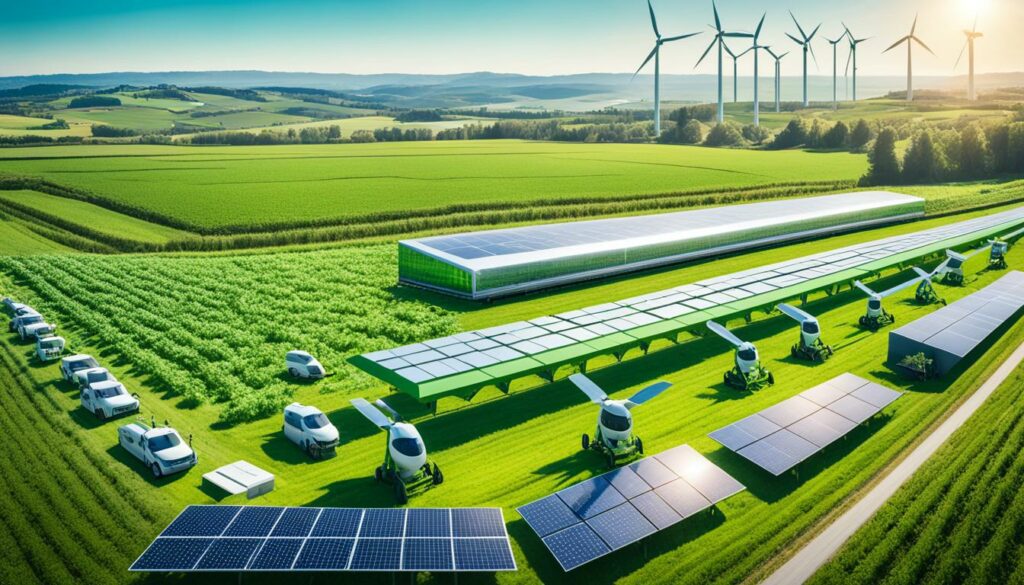
Soon, we’ll see more projects that help reduce food waste and make farms more productive. Things like drones, robots, and smart devices will play a big part. ICL is at the forefront, using AI and new fertilizers to boost their farming.
Buying food locally is becoming more popular. The idea got a boost from events like the COVID-19 pandemic, showing the benefits of short supply chains. It means fresher food and fewer miles it has to travel.
Looking to the future, our food sources are shifting towards plants and lab-grown meats. This is good for our health and the planet. Companies such as Beyond Meat and NovaMeat are making these new food options.
There’s also a big push for farming that helps the environment. This type of farming improves the soil, helps wildlife, and fights climate change. Plus, new tech like digital twins can predict what’s best for the land.
It takes a team effort from many to make these changes happen. Together with the latest tech and ideas, we can feed more people sustainably. This way, we also protect our planet.
Future farming partnerships are vital for advancing agriculture through shared goals and innovations. They are key as food production needs to grow by 68% by 2050. This is to meet the needs of a larger population. The use of digital agriculture is crucial, starting with the USDA in 2024. It helps deal with issues like high production costs and the effects of climate change. It also helps manage the shortage of workers.
It’s important to know that agriculture, forestry, and land use make up 18.4% of all global greenhouse gas emissions. The entire food system adds up to 26% of these emissions. So, we need to work together in farming to reduce these environmental impacts. Using technologies like IoT, which give farmers real-time data on their fields, can help a lot. It boosts productivity and sustainability.
Generative AI and digital twins are making big changes in farming research and decision-making. They help predict the outcomes of different farming methods. This leads to farming that is more efficient and better for the environment. Techniques like Adaptive Grazing and No-Till Farming are chosen for improving soil and capturing carbon.
Future work in farming is also changing how we make protein. The demand for meat substitutes could make up 10% of all meat by 2029. This shows more people prefer plant-based or lab-grown meat for health, ethical, and environmental reasons. It means we might need to grow crops differently.
There’s a growing demand for organic and sustainable food worldwide. New technologies like food-sharing apps and smart storage can help cut down the one-third of food we waste. This helps both the economy and the environment. Such solutions are becoming more powerful.
Investing in new farming methods is very important. The “Crops of the Future” project started with $10 million. However, this doubled to $20 million when others joined in. Nineteen companies and groups joined this project, showing a wide range of support. This includes seed and tech companies and others in the farming sector.
In the end, working together in farming will aim to make food more secure and farms more profitable. It will also focus on protecting the environment through creative and unified efforts.
Data-driven farming is changing agriculture, using big data. This method improves farming practices. By combining new tech and detailed data analysis, farming becomes more efficient and resilient.
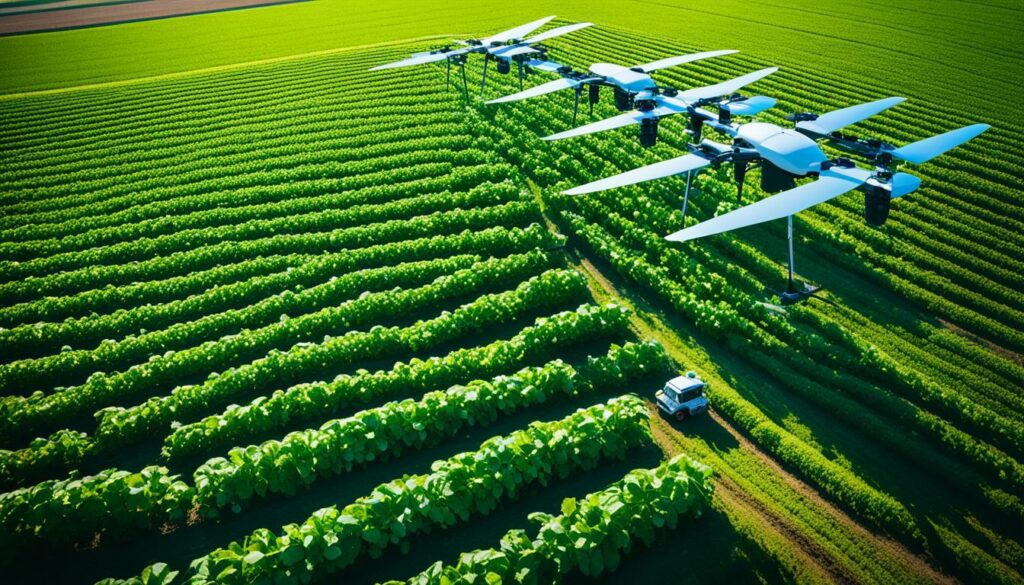
Big data farming gathers a lot of info from IoT devices, drones, and satellites. This data, when studied, gives insights into crop health, soil, and weather. Countries such as Turkey, Kenya, and Vietnam lead in digital farming.
In Africa, a study found 434 big data farming operations, with 194 projects ready to grow. Scaling up is critical for small farmers to be more productive and eco-friendly. GIZ and Mercy Corps AgriFin give farmers useful data for better resource use.
Predictive analytics is key in data-driven farming. It helps farmers forecast market needs, improve supply chains, and grow better crops. The digital farming market, worth USD 22 billion in 2023, is set to grow to USD 36 billion by 2028.
India is a leader in using predictive analytics for food security for its 1.3 billion people. With data strategies, India can produce and distribute food better, reducing climate and resource risks.
The impact of data in farming is clear. It’s not just a trend, it’s a big change in modern farming. Big data can help with better market access, financial services, and farm management.
The need for agricultural carbon management is getting more urgent. The U.S. agriculture sector has seen big changes. A lot of carbon programmes were started in the last 28 years, but most growth happened in the last five years. There are now 15 more programmes. However, not many farmers are joining in. This shows that we need to improve these programmes to get more farmers involved.
The agricultural carbon management is key because the global food system causes 31% of all man-made greenhouse gasses. At the same time, the need for food will jump by 56% before 2050. Almost 6% of food’s emissions come from using fuel on farms. So, managing carbon is critical to cut down on the sector’s greenhouse gas emissions.
A white paper suggests 12 important changes to make agricultural carbon management work better. These suggestions include making carbon more expensive, setting data standards, creating insetting programmes, and rewarding early users. These steps are meant to build a stronger system for handling carbon in farming. They aim to get more farmers to join in and help meet global climate goals.
The food system aims to cut global greenhouse gas emissions by 45% before 2030. It wants to keep global warming below 1.5 degrees Celsius. New fertilisers, like those with biodegradable coatings, are part of the solution. By making nutrients more effective for plants, these new fertilisers can change the agricultural carbon management plan.
Reflecting on the many trends in farming, it’s clear we need smart tech, strong rules, and good teamwork. With the world’s population heading to 9.7 billion by 2050, we must boost our food output by 70%. Advancements in things like LPWAN, 5G, and satellites are predicted to benefit the world by $500 billion by 2030.
Currently, only a quarter of U.S. farms use smart tech. The use of drones, AI, and IoT (Internet of Things) systems is growing. Companies like John Deere and Agmatix show us how new tools make farming more efficient and kinder to the planet. The use of satellite pictures, ground sensors, and automated machines proves how tech is changing farming.
By 2030, 25% of farming land might be ruined, and water could be 40% short. To combat this, we need new and smart solutions, teamwork, and investing in the right places. Things like growing food vertically and caring for cows sustainably can increase our food supply without harming the planet. Moving forward, teamwork in developing farming partnerships will be key. It helps secure our food, keeps our planet safe, and helps us stand strong against climate changes.
Trends in future agri-collaborations involve more technology. This includes automation and precision farming. Also, green practices, like urban and vertical farming, are rising. People are looking at new types of proteins too, such as those made in labs or from plants.
Working together is crucial in farming. It helps share new ideas and skills, dealing with big issues like food safety. By joining forces, we can be more efficient and make better food.
New tech, like robots and smart equipment, will change farming. It will make things more productive and less harmful to nature. Thus, the way we work together in farming will also get smarter and cleaner.
Leaders help farming become more modern and eco-friendly with their rules and support. They aim for our food to be safe and for farmers to do well. This makes a nation important globally in farming, in what we grow and how we do it.
City and indoor farming save resources and make food supply chains shorter. Growing plants in water and with fish help create a better and closer food system for everyone.
Using big data and smart predictions can make farm work better. It boosts how much we produce, saves resources, and helps us understand and fight climate change.
Working together in farming, but in a greener way, can help fight climate change. This includes how we treat the ground and new eco-friendly farming methods. These actions lower the harmful stuff farming does to the environment.
Future farming will see a lot of new tech and green money going into it. There will be more focus on new kinds of food like plant-based meat made by 3D printers. All this aims to fight issues like not having enough food and hurting the planet too much.
In the future, farming together will be all about goals that help everyone. This will include sharing new things and working together on food problems, making farms more profitable and kinder to the planet.
Farming can actually help stop climate change. By farming in a way that uses up less carbon or takes some out of the air, we play a huge role in keeping the planet safe.
Big companies working with the public can make farming better and cleaner. They help push for new ideas for a smarter food future. This also makes farming more about what we know, not just what we do.
Working together around the world will make food safer and more innovative for people. This means making sure everyone has enough to eat, without harming the planet in the process.
Non-traditional proteins, like those from plants or made in labs, are getting more popular. They offer a way to eat tasty food that doesn’t harm the earth so much. This is important as more people need to be fed well in the future.
Soon, we’ll see more farm work done by machines and smarter gadgets. Also, there will be more effort in making city farming greener. These steps aim to make food production more efficient and less harmful to our planet.
Looking ahead, the big plans are in new ways to make protein that’s good for us and the earth. We’ll also work on farming in a way that doesn’t use up the earth’s resources so fast. It’s all about making sure we can still eat well in the many years to come.